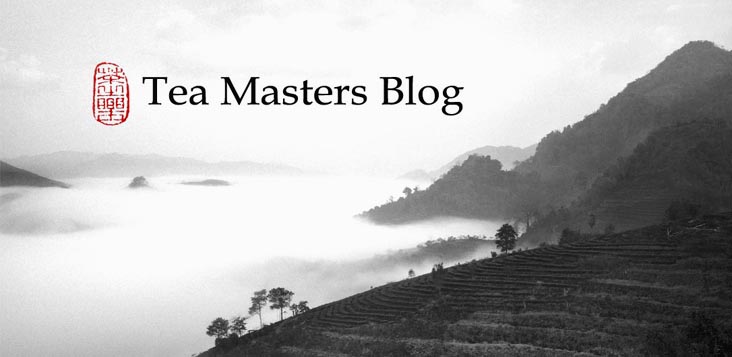Through a nice coincidence, a student who comes from Yixing joined this very first lecture about clays. And despite growing up there, it's the first time he saw so many Yixing clays. In the box below, Teaparker was able to gather clay from 19 different locations (or sometimes from the same mine, but from different layers).
It's not enough to simply identify the original location of the clay. The information about the layer is also very important. When you dig a hole in the ground, various layers with different colors appear. The deeper we dig, the further we go back in time, since these each layer is accumulation of sediments from a certain era. Not all layers are equally suited to make clay. The most suitable layer with the finest clay in a certain location is often called Nen Ni (fine clay).
But let's not throw too many confusing names around. What we need to know is that all these Yixing clays from these different locations and layers can be summed up with 3 colors:
 |
| Chalin clay area |
What is the characteristic of hungni when it comes from the ground? It's yellow! And it's very soft to the touch! It's so soft, it seems there's some powder that rubs off on the skin of our finger as we touch it. It feels powdery like talc.
 |
| Zhaozhuang Nen Ni clay |
 |
| Jianli Nen Ni clay |
As you can see from the picture, green clay has a more granular feel than hungni. It's the roughest, but also the one that it crushed the most easily. It's friable, brittle. Its color is the least even.
This green clay will turn into yellow when it's fired and will give us the pot color called 'duanni'.
.jpg) |
| Taixi clay well (top of mountain) |
Purple clay feels the hardest and doesn't brittle or turns into powder like luni or hongni. However, despite the rough look, its surface is also very smooth.
With zini, the color remains purple after firing.
Touching the 3 different types of clays proved very interesting and different from what we thought these clays would be like.
Touching a zhuni teapot right after touching a zhuni grade hungni clay also helped understand how the finesse, the smooth touch of the clay translates into the skin of the teapot!
Note: My spring 2015 Wenshan Baozhongs are now available here! And for further reading on Yixing wares, I've added this book with pictures of the National Palace's Yixing collection.










6 comments:
Great article! It is truly amazing seeing and touching both the clay samples and the fired teapots they turn into. The transformation of raw clay into an elegant teapot is truly incredible. The color transformation is also counter intuitive. Can't wait to see the results of our research on these samples at the Tea Institute!
Merci pour cet article, vivement le prochain. Cependant, quand est il de l'argile zisha ?
Thanks Ryan!
We are also very excited to read the various research you'll make with these clays.
Greg,
zisha est le terme général qui désigne toutes les glaises d'Yixing. On peut aussi l'employer plus particulièrement pour les glaises de couleurs pourpre, couleur majoritaire pour les Yixings traditionnelles.
La raison pour l'emploi du terme zisha même pour désigner une zhuni ou une duanni est qu'on peu observer des reflets violets sur toutes les théières d'Yixing.
Very fascinating!
Curious as to whether there are any updates to the research? I believe I also read the article at the Tea institute website.
There are many contradictory articles and information online as to the aging of clay (many say nowadays the clay isn't aged for more than a year or two, others say 40-60 years is pretty normal before being used.) This could either mean that even modern pots are still using huanglongshan clay and there is plenty to spare, or clay has a rapid turnover rate from harvesting to the finished pot. Also zhuni clay and processing is widely remarked about with little consistency in opinion. I've heard that as hongni clay ages the light and finest particles stay on top while the heavy particles sink and as a result the fine clay is skimmed off the top and this constitutes zhuni clay. But most info points to zhuni and hongni being totally different and even from different layers of clay. How different is zhuni really from the different mountains? Is zhao zuang really superior to huanglong and others?
Then there is the duanni/luni dilemma. Claims luni as the third "major" umbrella of clay along with zini and hongni. If this was the case then Ben Shan luni wouldn't be that rare. Other claims of duanni being that third umbrella with luni being a rarer subtype. But then the stating that duanni is a method of processing that always consists zini or zhuni plus luni so that would debunk the classification of duanni as a pure clay type. And how much "pure" other colored types (dahongpao, qinghuini, heini, tianqini) is actually processed separately and used for pots? And no I'm not talking about the oxide doped ones which I know are many.
Too many questions, too many opinions, too little answers!
Marc, Thanks for your interest and many questions. I will answer only those I can, according to what we learned from Teaparker during the Yixing Exhibition.
Yes, today's clays aren't aged as long as in the past. A few still do it slow and such clay is now mostly used only by top artists to make special pots.
According to Teaparker, Zhuni is extracted from rather thin layers in the earth and this type of clay is particularly soft (and yellow before firing).
The color of duanni before firing is green. It turns yellow with the firing.
The third big color of Yixing clay is zisha, purple.
The grey color (shark skin) color is obtained by mixing clays.
Post a Comment